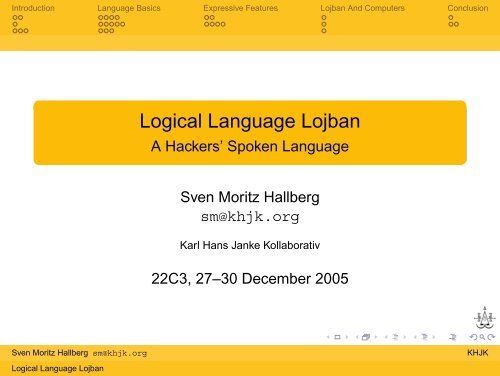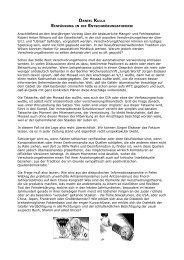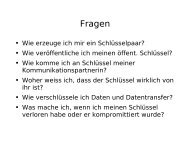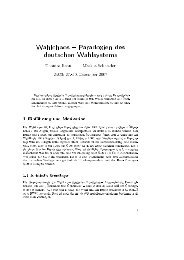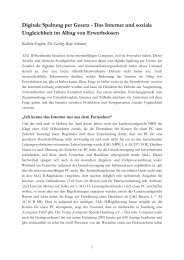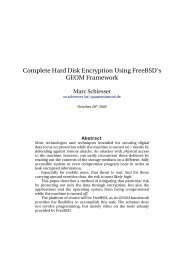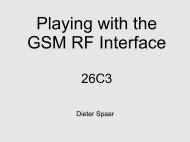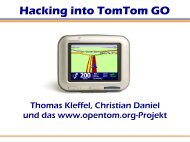Logical Language Lojban - A Hackers' Spoken Language
Logical Language Lojban - A Hackers' Spoken Language
Logical Language Lojban - A Hackers' Spoken Language
- TAGS
- lojban
- events.ccc.de
Create successful ePaper yourself
Turn your PDF publications into a flip-book with our unique Google optimized e-Paper software.
Introduction <strong>Language</strong> Basics Expressive Features <strong>Lojban</strong> And Computers Conclusion<br />
<strong>Logical</strong> <strong>Language</strong> <strong>Lojban</strong><br />
A Hackers’ <strong>Spoken</strong> <strong>Language</strong><br />
Sven Moritz Hallberg<br />
sm@khjk.org<br />
Karl Hans Janke Kollaborativ<br />
22C3, 27–30 December 2005<br />
Sven Moritz Hallberg sm@khjk.org KHJK<br />
<strong>Logical</strong> <strong>Language</strong> <strong>Lojban</strong>
Introduction <strong>Language</strong> Basics Expressive Features <strong>Lojban</strong> And Computers Conclusion<br />
What Is <strong>Lojban</strong>?<br />
constructed spoken (human-human) language<br />
based on predicate logic<br />
relatively young (1950’s – 1990’s)<br />
Sven Moritz Hallberg sm@khjk.org KHJK<br />
<strong>Logical</strong> <strong>Language</strong> <strong>Lojban</strong>
Introduction <strong>Language</strong> Basics Expressive Features <strong>Lojban</strong> And Computers Conclusion<br />
Outline<br />
1 Introduction<br />
2 <strong>Language</strong> Basics<br />
Alphabet And Pronounciation<br />
Basic Sentences<br />
Obtaining Your Objects<br />
3 Expressive Features<br />
Tenses<br />
Questions<br />
Compound Words<br />
4 <strong>Lojban</strong> And Computers<br />
5 Conclusion<br />
Sven Moritz Hallberg sm@khjk.org KHJK<br />
<strong>Logical</strong> <strong>Language</strong> <strong>Lojban</strong>
Introduction <strong>Language</strong> Basics Expressive Features <strong>Lojban</strong> And Computers Conclusion<br />
Outline<br />
1 Introduction<br />
2 <strong>Language</strong> Basics<br />
Alphabet And Pronounciation<br />
Basic Sentences<br />
Obtaining Your Objects<br />
3 Expressive Features<br />
Tenses<br />
Questions<br />
Compound Words<br />
4 <strong>Lojban</strong> And Computers<br />
5 Conclusion<br />
Sven Moritz Hallberg sm@khjk.org KHJK<br />
<strong>Logical</strong> <strong>Language</strong> <strong>Lojban</strong>
Introduction <strong>Language</strong> Basics Expressive Features <strong>Lojban</strong> And Computers Conclusion<br />
Outline<br />
1 Introduction<br />
2 <strong>Language</strong> Basics<br />
Alphabet And Pronounciation<br />
Basic Sentences<br />
Obtaining Your Objects<br />
3 Expressive Features<br />
Tenses<br />
Questions<br />
Compound Words<br />
4 <strong>Lojban</strong> And Computers<br />
5 Conclusion<br />
Sven Moritz Hallberg sm@khjk.org KHJK<br />
<strong>Logical</strong> <strong>Language</strong> <strong>Lojban</strong>
Introduction <strong>Language</strong> Basics Expressive Features <strong>Lojban</strong> And Computers Conclusion<br />
Outline<br />
1 Introduction<br />
2 <strong>Language</strong> Basics<br />
Alphabet And Pronounciation<br />
Basic Sentences<br />
Obtaining Your Objects<br />
3 Expressive Features<br />
Tenses<br />
Questions<br />
Compound Words<br />
4 <strong>Lojban</strong> And Computers<br />
5 Conclusion<br />
Sven Moritz Hallberg sm@khjk.org KHJK<br />
<strong>Logical</strong> <strong>Language</strong> <strong>Lojban</strong>
Introduction <strong>Language</strong> Basics Expressive Features <strong>Lojban</strong> And Computers Conclusion<br />
Outline<br />
1 Introduction<br />
2 <strong>Language</strong> Basics<br />
Alphabet And Pronounciation<br />
Basic Sentences<br />
Obtaining Your Objects<br />
3 Expressive Features<br />
Tenses<br />
Questions<br />
Compound Words<br />
4 <strong>Lojban</strong> And Computers<br />
5 Conclusion<br />
Sven Moritz Hallberg sm@khjk.org KHJK<br />
<strong>Logical</strong> <strong>Language</strong> <strong>Lojban</strong>
Introduction <strong>Language</strong> Basics Expressive Features <strong>Lojban</strong> And Computers Conclusion<br />
What Is <strong>Lojban</strong>?<br />
What Is <strong>Lojban</strong>?<br />
conlang<br />
predicate logic<br />
person is-going to-dest from-source<br />
developed since 1955<br />
current state finalized in 1997<br />
grammar and base vocabulary frozen<br />
Sven Moritz Hallberg sm@khjk.org KHJK<br />
<strong>Logical</strong> <strong>Language</strong> <strong>Lojban</strong>
Introduction <strong>Language</strong> Basics Expressive Features <strong>Lojban</strong> And Computers Conclusion<br />
What Is <strong>Lojban</strong>?<br />
Features<br />
unambiguous grammar<br />
phonetic spelling<br />
structurally simple<br />
easy to learn<br />
1350 root words<br />
combinable to millions<br />
regular – no exceptions<br />
Sven Moritz Hallberg sm@khjk.org KHJK<br />
<strong>Logical</strong> <strong>Language</strong> <strong>Lojban</strong>
Introduction <strong>Language</strong> Basics Expressive Features <strong>Lojban</strong> And Computers Conclusion<br />
What Is It For?<br />
Why Was <strong>Lojban</strong> Created?<br />
research into Sapir-Whorf hypothesis<br />
“The structure of one’s language constrains<br />
one’s thinking.”<br />
Null hypothesis: It doesn’t.<br />
Will native <strong>Lojban</strong>ists exhibit<br />
“new” thought patterns?<br />
Sven Moritz Hallberg sm@khjk.org KHJK<br />
<strong>Logical</strong> <strong>Language</strong> <strong>Lojban</strong>
Introduction <strong>Language</strong> Basics Expressive Features <strong>Lojban</strong> And Computers Conclusion<br />
Aims of the Talk<br />
My Aims With This Talk<br />
show that. . .<br />
<strong>Lojban</strong> is of more than scientific interest<br />
shows typical “hacker values”<br />
give a fun talk<br />
motivate actual use of <strong>Lojban</strong><br />
not a mobilization speech though<br />
Sven Moritz Hallberg sm@khjk.org KHJK<br />
<strong>Logical</strong> <strong>Language</strong> <strong>Lojban</strong>
Introduction <strong>Language</strong> Basics Expressive Features <strong>Lojban</strong> And Computers Conclusion<br />
Aims of the Talk<br />
Design Goals wrt. Sapir-Whorf<br />
same expressive power of natural languages<br />
but significantly different structure<br />
remove restrictions on creative and clear<br />
thought/communication<br />
Sven Moritz Hallberg sm@khjk.org KHJK<br />
<strong>Logical</strong> <strong>Language</strong> <strong>Lojban</strong>
Introduction <strong>Language</strong> Basics Expressive Features <strong>Lojban</strong> And Computers Conclusion<br />
Aims of the Talk<br />
Why Else Is <strong>Lojban</strong> Interesting?<br />
human-computer interaction<br />
more precise/powerful expression<br />
full set of logical connectives<br />
mathematical expressions properly expressible<br />
robust over noisy channels<br />
candidate for an international language<br />
Sven Moritz Hallberg sm@khjk.org KHJK<br />
<strong>Logical</strong> <strong>Language</strong> <strong>Lojban</strong>
Introduction <strong>Language</strong> Basics Expressive Features <strong>Lojban</strong> And Computers Conclusion<br />
Alphabet And Pronounciation<br />
The <strong>Lojban</strong> Alphabet<br />
’ , . a b c d e f g i j k l m n o p r s t u v x y z<br />
basic latin alphabet<br />
‘h’, ‘q’, and ‘w’ are not <strong>Lojban</strong> letters<br />
punctuation characters “ ’ , . ” represent sounds<br />
no question/exclamation mark, etc.<br />
Sven Moritz Hallberg sm@khjk.org KHJK<br />
<strong>Logical</strong> <strong>Language</strong> <strong>Lojban</strong>
Introduction <strong>Language</strong> Basics Expressive Features <strong>Lojban</strong> And Computers Conclusion<br />
Alphabet And Pronounciation<br />
Pronounciation of the Vowels<br />
a [a] father<br />
e [E] bet, lens<br />
i [i] green<br />
o [o] joke, note<br />
u [u] boot<br />
y [@] above<br />
vowel length doesn’t matter<br />
Sven Moritz Hallberg sm@khjk.org KHJK<br />
<strong>Logical</strong> <strong>Language</strong> <strong>Lojban</strong>
Introduction <strong>Language</strong> Basics Expressive Features <strong>Lojban</strong> And Computers Conclusion<br />
Alphabet And Pronounciation<br />
Pronounciation of the Consonants (excerpt)<br />
c [S] shirt<br />
j [Z] measure<br />
s [s] soldier<br />
v [v] voice<br />
x [x] loch, Ach<br />
z [z] magazine<br />
variations permitted, as long as sounds are distinguishable<br />
In particular, ‘r’ can be any rhotic sound.<br />
Sven Moritz Hallberg sm@khjk.org KHJK<br />
<strong>Logical</strong> <strong>Language</strong> <strong>Lojban</strong>
Introduction <strong>Language</strong> Basics Expressive Features <strong>Lojban</strong> And Computers Conclusion<br />
Alphabet And Pronounciation<br />
Pronounciation of Punctuation<br />
examples later. . .<br />
’ [h] ahead<br />
. [P] pause/stop<br />
, non-standard syllable break<br />
Sven Moritz Hallberg sm@khjk.org KHJK<br />
<strong>Logical</strong> <strong>Language</strong> <strong>Lojban</strong>
Introduction <strong>Language</strong> Basics Expressive Features <strong>Lojban</strong> And Computers Conclusion<br />
Basic Sentences<br />
Basic Sentence Structure<br />
predicate (“bridi”)<br />
person comes-to to-dest from-source<br />
arguments (“sumti”)<br />
syntax: x1 R x2 x3 . . .<br />
asserts that x1. . . xn are in relation R<br />
often matches subject-verb-object form of natlangs<br />
Sven Moritz Hallberg sm@khjk.org KHJK<br />
<strong>Logical</strong> <strong>Language</strong> <strong>Lojban</strong>
Introduction <strong>Language</strong> Basics Expressive Features <strong>Lojban</strong> And Computers Conclusion<br />
Basic Sentences<br />
The Cast<br />
Starring Pesco and Maya.<br />
Names will be “lojbanized”.<br />
transcribe phonetically<br />
must end in a consonant<br />
terminate with a pause (‘.’)<br />
original name spelling could be used<br />
but requires an “escape”<br />
Sven Moritz Hallberg sm@khjk.org KHJK<br />
<strong>Logical</strong> <strong>Language</strong> <strong>Lojban</strong>
Introduction <strong>Language</strong> Basics Expressive Features <strong>Lojban</strong> And Computers Conclusion<br />
Basic Sentences<br />
The Cast – <strong>Lojban</strong>ized<br />
<strong>Lojban</strong> name sumti form<br />
Maya ma,iar. la ma,iar.<br />
Pesco peskos. la peskos.<br />
la = flag word: “name follows”<br />
Sven Moritz Hallberg sm@khjk.org KHJK<br />
<strong>Logical</strong> <strong>Language</strong> <strong>Lojban</strong>
Introduction <strong>Language</strong> Basics Expressive Features <strong>Lojban</strong> And Computers Conclusion<br />
Basic Sentences<br />
An Example Relation<br />
max. 5 (direct) arguments<br />
klama – to come/go to<br />
argument order is significant<br />
place structure defines argument meanings<br />
klama – x1 comes to x2 from x3 via x4 using x5<br />
Sven Moritz Hallberg sm@khjk.org KHJK<br />
<strong>Logical</strong> <strong>Language</strong> <strong>Lojban</strong>
Introduction <strong>Language</strong> Basics Expressive Features <strong>Lojban</strong> And Computers Conclusion<br />
Basic Sentences<br />
Our First Sentence<br />
R = klama<br />
x1 = la peskos.<br />
x2 = la ma,iar.<br />
la peskos. [cu] klama la ma,iar.<br />
cu = flag word: “bridi follows”<br />
usually elidable<br />
obvious/unimportant trailing arguments elidable<br />
Sven Moritz Hallberg sm@khjk.org KHJK<br />
<strong>Logical</strong> <strong>Language</strong> <strong>Lojban</strong>
Introduction <strong>Language</strong> Basics Expressive Features <strong>Lojban</strong> And Computers Conclusion<br />
Obtaining Your Objects<br />
Pro-Sumti<br />
analogous to pronouns<br />
use in any sumti place<br />
mi me<br />
do you<br />
ti this here<br />
ta that there<br />
Sven Moritz Hallberg sm@khjk.org KHJK<br />
<strong>Logical</strong> <strong>Language</strong> <strong>Lojban</strong>
Introduction <strong>Language</strong> Basics Expressive Features <strong>Lojban</strong> And Computers Conclusion<br />
Obtaining Your Objects<br />
Articles<br />
le bridi [ku]<br />
le turns bridi relationships into sumti<br />
very close in meaning to “the”<br />
terminator ku usually elidable<br />
Sven Moritz Hallberg sm@khjk.org KHJK<br />
<strong>Logical</strong> <strong>Language</strong> <strong>Lojban</strong>
Introduction <strong>Language</strong> Basics Expressive Features <strong>Lojban</strong> And Computers Conclusion<br />
Obtaining Your Objects<br />
Article Example<br />
gunka – x1 works on x2 [activity] with goal x3<br />
“le bridi” means some thing(s) that would fit<br />
the x1 place of bridi.<br />
le gunka – “the worker(s)”<br />
Note: neither singular nor plural implied!<br />
Sven Moritz Hallberg sm@khjk.org KHJK<br />
<strong>Logical</strong> <strong>Language</strong> <strong>Lojban</strong>
Introduction <strong>Language</strong> Basics Expressive Features <strong>Lojban</strong> And Computers Conclusion<br />
Tenses<br />
Tenses<br />
temporal<br />
spatial<br />
realized by attaching modifier words to the bridi<br />
Sven Moritz Hallberg sm@khjk.org KHJK<br />
<strong>Logical</strong> <strong>Language</strong> <strong>Lojban</strong>
Introduction <strong>Language</strong> Basics Expressive Features <strong>Lojban</strong> And Computers Conclusion<br />
Tenses<br />
Temporal Modifiers<br />
pu in the past<br />
ca in the present<br />
ba in the future<br />
la peskos. ba klama la ma,iar.<br />
Pesco will go to Maya at some time in the future.<br />
relative to the time of speaking<br />
Sven Moritz Hallberg sm@khjk.org KHJK<br />
<strong>Logical</strong> <strong>Language</strong> <strong>Lojban</strong>
Introduction <strong>Language</strong> Basics Expressive Features <strong>Lojban</strong> And Computers Conclusion<br />
Questions<br />
Questions<br />
“Is it true that . . . ?”<br />
fill-in-the-blank(s)<br />
“What is in relation . . . ?”<br />
“In which relation(s) are . . . ?”<br />
Sven Moritz Hallberg sm@khjk.org KHJK<br />
<strong>Logical</strong> <strong>Language</strong> <strong>Lojban</strong>
Introduction <strong>Language</strong> Basics Expressive Features <strong>Lojban</strong> And Computers Conclusion<br />
Questions<br />
Truth-Value Questions<br />
prefix entire statement with xu<br />
xu la ma,iar. klama la peskos.<br />
“Does Maya come to Pesco?”<br />
Sven Moritz Hallberg sm@khjk.org KHJK<br />
<strong>Logical</strong> <strong>Language</strong> <strong>Lojban</strong>
Introduction <strong>Language</strong> Basics Expressive Features <strong>Lojban</strong> And Computers Conclusion<br />
Questions<br />
Fill-In-The-Blank for Relations<br />
put mo in the bridi place<br />
“What is <strong>Lojban</strong>?”<br />
la lojban. mo<br />
(“In which relationships . . . ?”)<br />
Sven Moritz Hallberg sm@khjk.org KHJK<br />
<strong>Logical</strong> <strong>Language</strong> <strong>Lojban</strong>
Introduction <strong>Language</strong> Basics Expressive Features <strong>Lojban</strong> And Computers Conclusion<br />
Questions<br />
Fill-In-The-Blank for Arguments<br />
put ma in one or more sumti places<br />
“Who goes where?”<br />
ma klama ma<br />
Sven Moritz Hallberg sm@khjk.org KHJK<br />
<strong>Logical</strong> <strong>Language</strong> <strong>Lojban</strong>
Introduction <strong>Language</strong> Basics Expressive Features <strong>Lojban</strong> And Computers Conclusion<br />
Thoughts About <strong>Lojban</strong> Applied to Computers<br />
using lojban for human-computer interaction<br />
need to assume some level of proficiency in <strong>Lojban</strong><br />
no deep investigation, just ideas for research<br />
Sven Moritz Hallberg sm@khjk.org KHJK<br />
<strong>Logical</strong> <strong>Language</strong> <strong>Lojban</strong>
Introduction <strong>Language</strong> Basics Expressive Features <strong>Lojban</strong> And Computers Conclusion<br />
Natural <strong>Language</strong> Interface<br />
Talk To Your Computer In <strong>Lojban</strong>!<br />
authorative unambiguous grammar specified in YACC<br />
EBNF version available<br />
therefore, easy and complete parsing<br />
recognize questions and imperatives<br />
maybe implement natural language interface<br />
with pattern matching?<br />
specialized subsets of <strong>Lojban</strong> maybe<br />
Sven Moritz Hallberg sm@khjk.org KHJK<br />
<strong>Logical</strong> <strong>Language</strong> <strong>Lojban</strong>
Introduction <strong>Language</strong> Basics Expressive Features <strong>Lojban</strong> And Computers Conclusion<br />
Internationalisation<br />
<strong>Lojban</strong> As I18n Base <strong>Language</strong>?<br />
<strong>Lojban</strong> is easy to produce.<br />
I18n translates messages from some base language.<br />
problems with incorporating dynamic data<br />
structure of neither base nor target lang. understood<br />
<strong>Lojban</strong> beneficial if used as the base language?<br />
Autoranslation to (pseudo-) English is already available.<br />
Sven Moritz Hallberg sm@khjk.org KHJK<br />
<strong>Logical</strong> <strong>Language</strong> <strong>Lojban</strong>
Introduction <strong>Language</strong> Basics Expressive Features <strong>Lojban</strong> And Computers Conclusion<br />
Programming<br />
<strong>Lojban</strong> For Programming<br />
use <strong>Lojban</strong> for naming identifiers<br />
no spaces needed between words<br />
questions/imperatives again<br />
relations?<br />
functions?<br />
Sven Moritz Hallberg sm@khjk.org KHJK<br />
<strong>Logical</strong> <strong>Language</strong> <strong>Lojban</strong>
Introduction <strong>Language</strong> Basics Expressive Features <strong>Lojban</strong> And Computers Conclusion<br />
How To Learn <strong>Lojban</strong><br />
How To Learn <strong>Lojban</strong><br />
basic grammar: only a few days<br />
you need vocabulary<br />
practice!<br />
flash-card programs available<br />
#lojban (Freenode)<br />
build a personal word list<br />
Sven Moritz Hallberg sm@khjk.org KHJK<br />
<strong>Logical</strong> <strong>Language</strong> <strong>Lojban</strong>
Introduction <strong>Language</strong> Basics Expressive Features <strong>Lojban</strong> And Computers Conclusion<br />
Conclusion<br />
Summary<br />
<strong>Lojban</strong> is general, clean, simple, and precise<br />
=⇒ powerful!<br />
<strong>Lojban</strong> can help us make clearer HCI’s<br />
(Return of the Command Line!)<br />
Outlook<br />
We need <strong>Lojban</strong> speakers.<br />
How can we employ <strong>Lojban</strong> in programming/machine<br />
interfaces?<br />
Sven Moritz Hallberg sm@khjk.org KHJK<br />
<strong>Logical</strong> <strong>Language</strong> <strong>Lojban</strong>
Introduction <strong>Language</strong> Basics Expressive Features <strong>Lojban</strong> And Computers Conclusion<br />
Conclusion<br />
Further Reading<br />
The Paper: khjk.org/sm-2005-lojban.pdf<br />
answering ;)<br />
narrowing meaning and compound words<br />
logic<br />
See www.lojban.org<br />
“Level-0 Book”<br />
Beginner’s Lessons<br />
“Reference Grammar”<br />
Sven Moritz Hallberg sm@khjk.org KHJK<br />
<strong>Logical</strong> <strong>Language</strong> <strong>Lojban</strong>


